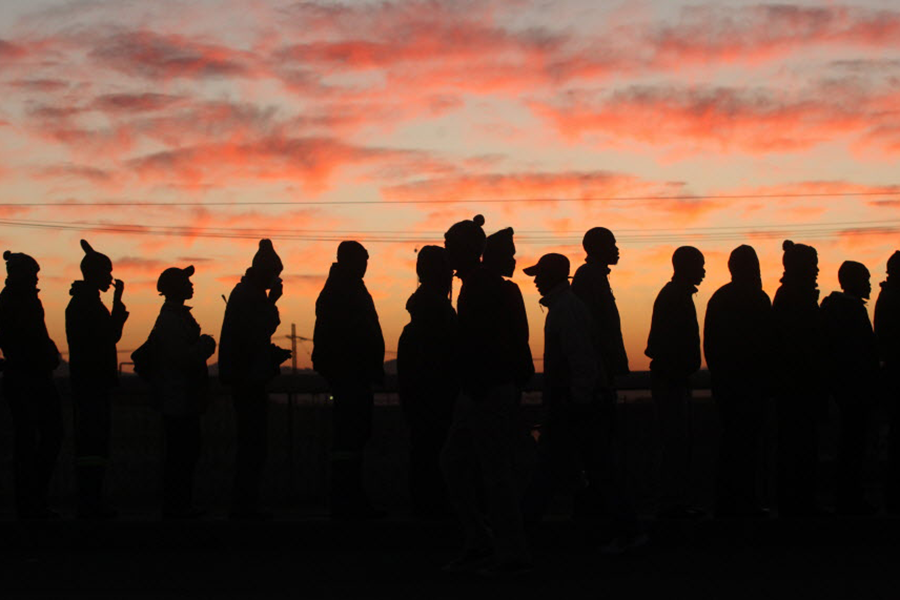South Africa's longest strike ends. Now what?
Loading...
| Marikana, South Africa
At daybreak this morning thousands of relieved platinum workers in the dusty mining town of Marikana headed back to work, signaling an end to the longest and costliest strike in South Africa’s history.
Yet despite the celebratory atmosphere in the town, which lies 80 miles northwest of Johannesburg and has been the scene in recent years of wrenching violence, people here are aware that the real impact of the five-month strike is likely to be fewer jobs. And for South Africa’s government and businesses, labor woes are far from over, with strike action looming in the metal works industry next week. Minerals are the largest single sector of the economy, and the nation is the world's biggest producer of platinum.
Bid for better wages
On Jan. 23, 70,000 miners laid down their tools in a cry for better wages and benefits that many had been demanding for several years. Months of stalemated negotiations and intractability followed, resulting in Tuesday's wage deal, which the Association of Mineworkers and Construction Union (AMCU) signed with the world’s top platinum producers, Lonmin, Anglo-American Platinum, and Impala Platinum.
That ended a crippling strike that pushed the economy into contraction in the first quarter. Ratings agency Standard & Poor's cited the strike action as one of the reasons it downgraded South Africa’s credit rating last month.
The three-year deal will see mine workers receive an annual pay raise of around $94 per month. For many, this amounts to a substantial 20 percent increase in basic wages – far less than the 100 percent increase the AMCU originally demanded, but still above usual pay raises.
“We are on the right track to bring back the dignity of the working class, in particular, in the mining industry," said an impassioned AMCU president Joseph Mathunjwa at a rally on Monday. "It’s a victory that the mine workers have received a better salary in the last 20 years of this democracy, that is why we should be joyful."
Replenishing the ATMs for the first time in months
In Marikana, mine workers were triumphant as the previously dead streets bustled with people once again. A cash truck rolled past shop fronts to replenish an ATM for the first time in months. Lines stretched out from supermarkets and snaked around corners.
“It is very good to go back to work because for five months we have been struggling a lot," says Godfrey, a local miner who only gave his first name. "We finally got a deal.... Everything is going to be OK and we’ll be back to normal. The reward was worth the agony,”
But the strike has cost the three mining firms a combined $2.25 billion in lost revenue. With pay raises and diminishing profits even before the work stoppage, companies will be squeezed even harder.
Under the settlement terms, many workers will not be able to go back to their jobs immediately, with companies stipulating health checks and retraining before allowing employees back underground. Some firms estimated employees may be able to start working next week, with full production taking up to three or four months.
Producers are widely expected to undergo restructuring, something that could lead to job cuts and, potentially, wild-cat strikes or violence. Mr. Mathunjwa has already indicated that AMCU will oppose any layoffs.
However, analysts say that mining employment will fall. Between 1994 and 2013, mining employment fell from 1.4 million to 550,000 even though mining production was up by 20 percent.
Adcorp, a South African research company, forecasts a drop of around 225,000 jobs over the next three years.
In the wake of the strike, the government is keen for legal "strike breaking" mechanisms to allow the courts or the state to intercede during protracted and expensive standoffs.
On June 23, a labor court dismissed a bid by AMCU to strike at operations owned by three of South Africa’s major gold mines. The union president has vowed to fight legislation aiming to curb strike action, stating it would be unconstitutional.
The new federal minister of mining, Ngoako Ramatlhodi, has said he wants to push through labor reforms, including possible legislation to limit the length of industrial action. But with strikes protected under the Constitution, this will be a huge challenge.
“Legislation being a political solution is going to be impossible because any attempts to curtail union activity will be hotly resisted by AMCU and all other unions as well,” says Loane Sharp, a labor economist with Adcorp who says that changes must be considered at the constitutional court.
AMCU has enjoyed a sharp rise in membership in recent years, winning over members from rival unions. But Mr. Sharp argues that unions in South Africa may be losing their clout as membership has fallen from 3.3 million to 3 million in 2013, costing $9 million in dues collection.
Further, it appears the country will barely have time to catch its breath before its next labor challenge.
The National Union of Metalworkers of South Africa (NUMSA), the country's biggest union with more than 200,000 members, is threatening to strike starting July 1.
“It’s very realistic, it is credible, but unionization is not nearly as high in the manufacturing sector where NUMSA is active for it to be a protracted strike,” predicts Sharp.





